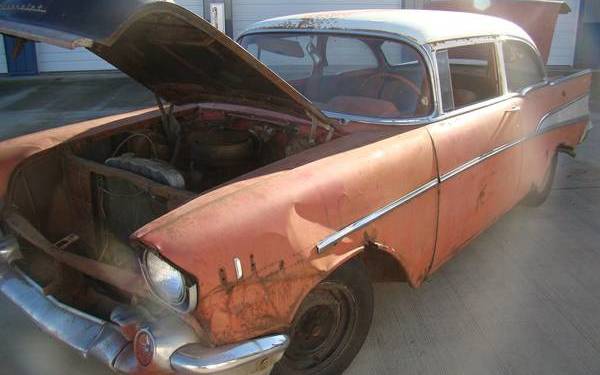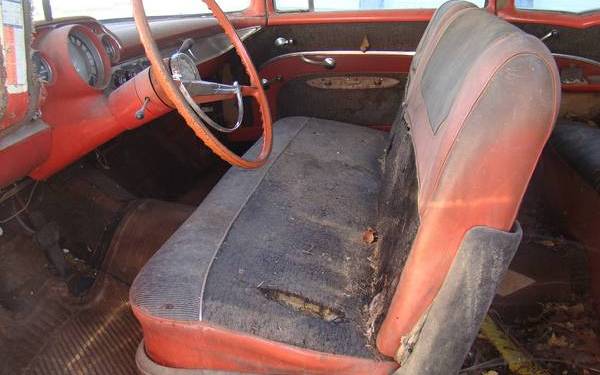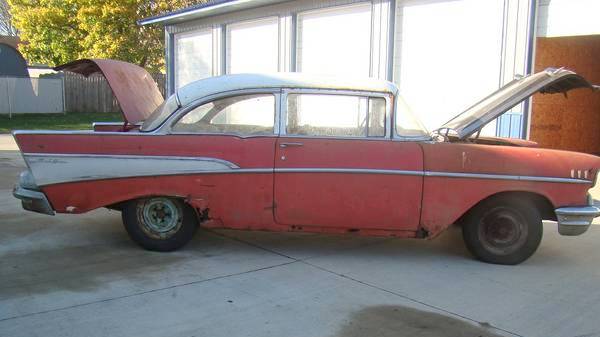This 1957 Chevy Bel Air two-door sedan is offered for sale here on Milwaukee’s craigslist with an asking price of $4,400. While there are always ’57 Chevys available on CL, but this one stands out from the crowd because of it’s originality and completeness, desirable color and trim combination, and it’s original V8 engine complete with original air cleaner and generator!
The seller states that it has been parked for almost a half century, so while it’s obviously not in running condition, it sure gives one hope to look under the hood and see the probably original 283 engine still in place and connected. It would be a fun weekend project to remove the valve covers and spark plugs, pre-soak the engine with Kroil or PBLaster, hook up a fresh battery and try to get lucky.
As far as the body goes, we’ve seen lots worse from other areas of the country that are supposed to have better cars than here in the Midwestern rust-belt. The driver’s fender aside, the rest of the body is do-able. Or better yet, get it roadworthy and drive it as-is, with the coolest patina in town. This is the kind of car that will get notes left on it if left parked at the grocery store while you’re inside picking up a few things. A genuine head-turner.
The neat original orange body color is paired up with matching orange and black interior in untouched, although rough condition. It’s all there and still in place, including the radio, knobs, steering wheel, and many other items like these that are so often missing from cars like this. Remember a few years back when just the correct front seats out of these two door cars were bringing almost a thousand bucks?
The exterior trim appears to be mostly present and accounted for. It’s still installed where it’s supposed to be on the body and not in a tangled wad in the trunk. It appears that at least two of the original body-colored wheels are included. While the fact that many sellers choose to not spend an hour picking up trash and vacuum interiors interiors before they photograph their classic car will always mystify me, this car still looks interesting. If it were mine, I’d get it roadworthy and otherwise mechanically functional, replace a few emblems, and drive it as-is and enjoy for awhile. It’s probably worthy of a full restoration and that fact isn’t going to change anytime soon!








Agreed that it’s worthy of restoration.
What ever that clump of debris is on the back seat, it needs to be removed asap….
Complete original appearing car. All you need is one of those new reman ’57 Chev complete bodies and transfer all the parts off this rusty piece of junk, after all its not a Porsche Speedster
It always baffled me back in the 1970s how quickly cars from the 50s and 60s went off the road.
For example: I just retired a 1991 Ford F-150, not because it didn’t run perfectly, but because I moved from Ohio to Florida and didn’t plan to bring in down here. So there’s a 24-year-old truck still in service. By contrast, here’s a ’57 that only ran 9 years before being retired for whatever reason, (but certainly not because the parts weren’t available, I assume).
Back in the 70s when I started driving, cars from the late 50s were very rare to see still running. Heck, in ’76 a friend bought a ’62 Skylark for a couple hundred bucks, and the thing was just perfect with maybe 20K miles on it.
So, I guess my question is: why did these cars not go 15 or 20 years? Or was it just that the economy was so good in those days that everyone could afford a new car after a few years, and the 10+ year-old cars were simply junked. Surely the dealers wanted to sell new cars, so maybe in ’65, a ’57 Chevy was nothing but an old car. I’d be interested in some other opinions on this.
Rex,
I recently started wondering the same thing. I just got a 76 BMW back on the road and it dawned on me the car was only 11 years old when I was in high school and I NEVER saw these on the road back then.
Out here people traded their cars every 4 or 5 years to ensure reliability, or at least my father did. And the story of two of them is illustrative. He traded a 1959 Chev Bel Air sedan off on a 1964 Galaxie sedan. The Chev was purchased by a man with a young family, but a couple of years later was involved in an accident with substantial front end frame damage. It was sold for scrap/parts in 1967 – eight years old. The Galaxy was traded off on a 1969 Chev Impala. With the 390 4V standard in the Galaxy as the attraction, a guy just out of high school bought it. It was driven into the ground within two years – 7 years old. Neither of the cars was over 60,000 miles when Dad traded them. I bought an Impala new in 2008 and recently traded it in on a 2016 GMC – eight years old and just over 110,000 miles. And I am sure it will make a good car for some family for a few years yet.
You’re right. And to think, I bought one of these from the corner gas station in ’69 for $10. My first car and my first accident. (Not my fault although, I was speeding.). Between the other’s guys insurance and the junkyard I parlayed that $10 investment into $110.
“Or was it just that the economy was so good in those days that everyone could afford a new car after a few years”
That’s a question for the ages.
Certainly the industry worked hard to convince everyone that they could afford a new car every few years!
While in San Diego in 1977, I almost bought a ’55 Chevy at a dealership for $1,050. On my way back home, I spotted one of the last intact ’57 Bel Air cars, in need of suspension work, at least, for just $400 in a used car lot in southern Illinois. Thirty-nine years later I finally found an El Paso ’57 Sport Coupe with a ’73 Monte Carlo 350 and no transmission for $7250 to mark the changes in the market for such old cars. Off the road since 1987.
At last, circumstances have allowed me to proceed with the restoration and a trip to a speed shop to straighten the chassis and to weld in brackets for a 396 set-up to have the car back on the road once more in two years.
Restoration is a very slow process when original equipment is used again, washing away 65 years of time gone by. It is my guess that the winter weather throughout most of the country played the biggest part in aging the older car a several ways, to include running through salty potholes and sliding into other vehicles, etc. The costs of insurance took many off the road and filled garages and barns. Many have been restored and it is still rare to see them, except for summertime car shows and gatherings. I found a 1941 dime in the right rocker panel when I took the old car apart that added greatly to the archeological nature of the work, as I wondered what the Bel Air has been through over the years.
I think it is a combination of a few things. People not taking care of cars with the long term in mind, simply junkie them when it’s time for a new one, but most of all I feel like it’s because as manufacturing processes have gotten better and tolerances tighter; machine work better etc, as time went on cars got better and better. My daily driver toyota has 310k n going strong. They don’t make them like they used to, and that’s awesome!
Agreed and agreed. The strange, quiet beauty of the whole thing, is how many of them were saved. Taken off the road around 1968 or so….and kept in someone’s garage or barn for four decades!
I read somewhere awhile back, that of the 1.4 million ’57 Chevys produced in all body styles, it is believed that as many as a third of them are still in existence! I wonder how many other mass-produced cars have that kind of survival rate….
I own an original ’55 Olds Holiday Sedan with only 69,000 miles on it. It is in need of a lot of work on the areas of suspension and steering just to keep it drive-able.
Since I am the same age as the car, I remember the 60’s quite well. I remember that a car with 50,000 miles on it was no longer considered reliable and for that reason was sold or traded in. I owned a 1993 Taurus SHO that I sold with over 400,000 miles on it and still got $2500 for it. Yes, it’s true that they don’t build them like they used to and thank heavens for that!
I agree, this car has all the right attributes, especially considering how many of these have been decimated over the years.
The fact is the 50’s and 60’s cars were just plain worn out in 90k miles. Take a piston to cylinder clearances 0.0015″ to 0.002″ when new, 0.005″ to 0.006″ when worn out so with only around 0.004″ of wear from new to worn out its amazing that these cars lasted as long as they did. That same kind of wear throughout the whole car, plus the attack of the tin worm makes you understand why there was a 10 year life span.
Easy 30 – 40k needed to restore this one..
We will never have a dog nor an old car at our house and tis a shame. I just got rid of a 2004 Chevy Colorado that had spent all it’s life in Michigan and had no rust holes and $250 worth of rust touch up. What was a surprise to me was the 5 cylinder engine still got over 4,000 miles per quart of synthetic oil. I could have put a rack and pinion in and some major brake work, but this was my daily driver and it was about to start nickel and diming me. I forgot to mention it had 204,000 miles and was extremely reliable. I believe with most vehicles, it is how they are maintained and driven that will determine their life span.
In the mid sixties no one would have had any use for it except a high school kid with $50 to buy a car. By the early 70’s, two door hardtops were starting to get interest with 2 door sedans right behind them. 4 door sedans and HT’s were not wanted- I bought a sierra gold and white ’57 4 door HT in ’74 for $150 in pretty good shape. 2 doors, Nomads and convertibles started to take off in the early 80’s and never stopped.
The passage of time makes looking back on the wheres and how people treated their cars velly interesting. Back in the late sixties early seventies the idea that a car had a 100,000 miles on it was downright amazing. We were conditioned to believe they had to go. As a kid I was always buying cars from 10 to 25 years years old for hundreds of dollars at most. ’60 Squarebird in ’74 for 250.00! mint! a ’63 Lincoln Continental in ’75 for 700.00 mint! MG’s, Cadillacs, Austin Healey 3000, ’56 Chevy 4 door hardtop for 250,00 in 1972…$250.00. The list goes on.BMW 2002’s, ’67 VW 21 window busses…everything and anything people drool over and pay big bucks for today most of us have had…and drove and loved them because we had a thing for old iron. Tha’ts why I just shake my head and laugh when I watch auctions….either these folks didn’t know enough to buy them and drive them when you could, or are just so in love with the memory that they’ll pay through the nose today for the same car. Nutty. Thats why I love this website. Carguys. Period.
Woodie Man, you are so correct!
I look back at the now considered classics I butchered up for oval track and drag racing. They were plentiful and cheap.
What are we driving today that might be considered a classic one day, or will it never happen? Guess it doesn’t really matter as I will be way past dead before any modern car could possibly have the status of a classic or barn find.
Even though I mostly do my own wrenching, for years I would never touch a car with over 60,000 miles on the odometer. It was just worn out was what I learned. Right now I drive a 1950 Ford F1 with over a hundred thousand miles on it, and a 1993 F150 with 250,000 miles on it. Of course out here in Nevada we don’t worry about rust like I did where I grew up, in NH.
Looks like the one I traded in on a 62 Chevy convertible.
As an ode to the million or so of these that are no longer in existence, I remember going to the local oval dirt track when I was a kid with my parents in the early ’70s, and in some of the “modified” and “street stock/bomber” car heat races, almost every single car in them were tri-fives! If they were lucky, the drivers would get a season or two out of the cars before they were destroyed, and then they were gone forever.
I guess that’s all part of the big story that makes them desirable now.
Rust claimed a lot of cars prior to the 1990s. My first car was a 1975 Chevy 1/2 ton pickup that was just 7 years old in 1982. There were holes in the floor, doors, and bed big enough to fall through. I paid $175 for it as it only had 75000 miles. Until recently, my newest car in my current fleet of 5 was 8 years old and none have any rust!
I had a ’57 Chevy 2 door hardtop in much the same condition as this one but w/o the rust. I paid $800 for it in 1984, kept it two years and got the engine unstuck and running before selling it for $1600. It needed a full resto and I was just 18 and broke. I wish I would have hung on to that car.
In the mid 70’s GM was using sheet metal on there trucks that had some bad batching in its metallurgy, these trucks were rusters you could walk past one with a glass of warm water and it would start to rust. The bodies didn’t last 3 years, I remember a lot of POed people up here in Canada. I also remember seeing a lot of them around like that, and like you said Mark you could stick your head through the holes in the sides quite literally.
Bought my first car, a 1957 Chevy Bel Air 2 dr hartdtop in 1971 for $ 550.00. Got it from the original lady owner. Had 32,000 miles, 283 powerpak , power steering, electirc wipers, turboglide & plastic covers on the seats. There was a dent on the front fender very similar to the one in the article. They just weren’t going for big bucks back then.